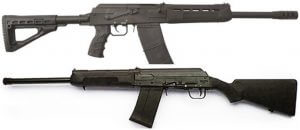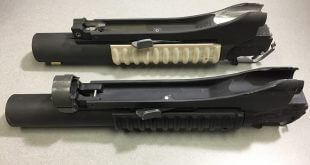It was kind of surreal. Watching Donald Trump walk to the podium on election night and claim victory was a beautiful sight.
Like many of you, I supported Donald Trump. I voted for him and I campaigned on his behalf. While I thought he certainly could win, I didn’t know if he would and I prepared for the worst.
With the election of Donald J Trump comes an opportunity, for the first time in decades, to begin rolling back the onerous gun control laws, regulations and executive orders that we have been complaining about for years.
As we get closer to Trump taking office, we will begin launching major advocacy pushes to get these goals realized. But here is the exhaustive list (in no particular order) of every gun control executive order, law, and regulation that must be repealed or amended.
- Suppressor Regulation in the National Firearms Act of 1934
This one gets liberals all riled up, but the NFA needs to change. There is no reason for short barreled rifles/shotguns and suppressors to be this heavily regulated. Even in countries in Europe, where gun control is much stricter, suppressors are unregulated and barrel length isn’t as criminalized.
The Hearing Protection Act now holds the title of the most viewed piece of legislation on the Library of Congress’ website. The legislation is simple: instead of forcing gun owners to jump through hoops and wait months for a simple background check to be performed by the ATF, it amends the NFA to treat suppressors like any other firearm. Only a NICS check would be necessary to take a suppressor home with you.
When Donald Trump Jr sat down for an interview with SilencerCo’s CEO, Joshua Waldron, he was asked point-blank whether President Trump would support the Hearing Protection Act and Donald Jr. responded, “yes.”
This will be one of our first legislative pushes once Trump takes office and the new Congress is seated.
- 18 USC 925(d)(3) of the Gun Control Act of 1968: Sporting Purposes
In 2008, the Supreme Court ruled in Heller v DC that the Second Amendment protects an individual right to own a firearm for self-defense, unconnected with military service. Yet, many parts of our gun control laws still treat gun ownership in terms of “sport.”
Section 925(d)(3) reads:
“The Attorney General shall authorize a firearm or ammunition to be imported or brought into the United States or any possession thereof if the firearm or ammunition… is generally recognized as particularly suitable for or readily adaptable to sporting purposes, excluding surplus military firearms…”
What 925(d)(3) does is apply a ridiculous “sporting purposes” test to all firearms being imported into the country. Under the provision, the Attorney General can, for example, block a Saiga shotgun (top) from being imported because pistol grips aren’t considered to be “sporting.” But if the manufacturer removes the pistol grip and installs a traditional-style stock onto the firearm (bottom), it is all of a sudden reclassified as a “sporting” arm and allowed to enter the country.
This is just a waste of time. If a gun is legal for civilians to own (i.e. it is not a full-auto weapon) then it should be legal to import. Forcing manufacturers and importers to jump through hoops to meet a standard that the Supreme Court expressly shot down is irrelevant to the purposes of the 2nd Amendment.
Americans have a right to own firearms for self-defense and it is unreasonable to limit imported long-guns to just those designed for “sport.”
- 18 USC 922(r) of the Gun Control Act of 1968: Foreign Parts
As a corollary to 925(d)(3), Congress passed a provision known as 922(r) detailing how many foreign parts a rifle or shotgun can have.
If you import a foreign parts kit for, say, an AK-47 or Sten Mk2, even if you build them to be semi-automatic only, you would be breaking the law if you don’t add a requisite number of US-made parts. Not only that, but if you purchase a “sporting rifle,” like the unconverted Saiga shown above with the hunting stock, it is against the law to use a “high capacity” magazine. In order to use a larger magazine, you would need to add in the requisite number of domestic parts.
922(r) lists 20 different parts that firearms typically have. They are,
(1) Frames, receivers, receiver castings, forgings or stampings, (2) Barrels, (3) Barrel extensions, (4) Trunions, (5) Muzzle attachments, (6) Bolts, (7) Bolt carriers, (8) Operating rods, (9) Gas pistons, (10) Trigger housings, (11) Triggers, (12) Hammers, (13) Sears, (14) Disconnectors, (15) Butt stocks, (16) Pistol grips, (17) Forearms/hand guards, (18) Magazine bodies, (19) Magazine followers, and (20) Magazine Floorplates.
To comply with the 922(r) regulation, a rifle or shotgun can have no-more than TEN of these parts be made overseas. A completely arbitrary number…
In practicality, this is next to impossible to enforce. If you build a firearm from a parts kit at home (which we are currently doing), a Representative from the ATF isn’t going to show up and force you to field strip it while he or she documents the country of origin for its parts. Since most non-receiver parts aren’t serialized, it would be impossible to enforce this law anyway.
So gun owners are force to jump through hoops to comply with a pointless law that is literally unenforceable. This is a textbook definition of an unnecessary gun control law.
Read Part 2!
If you have any suggestions for which laws, regulations, and executive orders you think should be immediately repealed, let us know in the comments below!
 Second United
Second United





